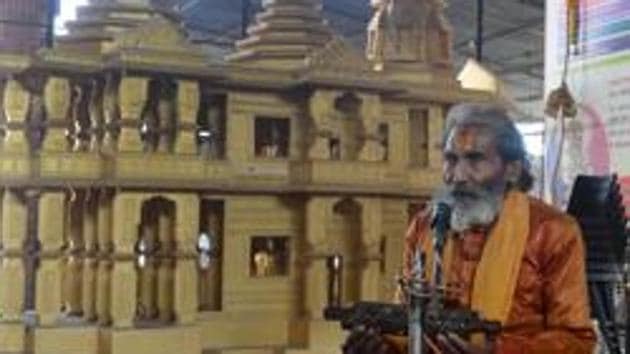Can the surplus acquired land be given to Nyas?
The question now, however, is: Will the apex court restore the land before settling the title suit and, can the land be transferred to the Nyas?
Way back in February 2002, the Ram Janmabhoomi Nyas (RJB Nyas), formed to espouse the construction of a Ram temple on the disputed Ayodhya site, sent a letter to then Prime Minister Atal Bihari Vajpayee, demanding restoration of surplus Ayodhya land, acquired by the Centre under a 1993 law, to the trust.

The letter, detailing various provisions of the Central Acquisition Act and legal rulings, had mentioned a meeting its functionaries had with Vajpayee in January 2002, in which they had appealed to him to hand over the undisputed land, out of 67.703 acres acquired by the government, to the undisputed owners – the Nyas.
“... the Central government may retain in its possession sufficient area of undisputed land, adjacent to the disputed structure, so that a reasonable extent out of that area may be handed over to the successful party, if and when the suits are decided. While doing so, out of the undisputed area belonging to RJB, which abut the disputed area on the western side of the disputed land, may also be retained with the Central government to which RJB is agreeable.”
Almost 17 years after the trust’s request, the central government moved an application in the Supreme Court last month demanding modification of the March 2003 judgment to restore surplus land, which is undisputed, to the rightful owner, the RJB Nyas.
The question now, however, is: Will the apex court restore the land before settling the title suit and, can the land be transferred to the Nyas?
Jafaryab Jilani, advocate pleading the case of the Sunni Waqf Board, says, “The land can be transferred only after completing the four purposes clearly defined in the Central Act -- construction of temple, construction of mosque, civic amenities for pilgrims and a library -- as it would be difficult to earmark the surplus land before that.”
Secondly, can the Centre transfer land to the same trust? Perhaps not. According to the Acquisition Act, it can be transferred to any authority or other body, or trustees of any trust set up on or after the commencement of the acquisition ordinance .
Justice (retired) Palok Basu, who died on Wednesday, had some years back initiated a signature campaign in Ayodhya to amicably resolve the contentious issue. This was his take on the issue, “I am no one to judge, but my personal opinion is that nothing is going to happen on the Centre’s plea as the court has addressed the issue thrice in different cases -- in 1994, 2002 and again in 2011.”
Despite the twists and turns in the legal history of the temple tangle since the first legal case was filed in 1885, the landscape of the RJB complex has drastically changed since the Vishwa Hindu Parishad (VHP) and its associate, the RJB Nyas, launched the Ram temple movement in 1984.
While the VHP stepped up its campaign by launching ‘shila yatras’ and ‘shila pujan’ in 1988-89, the Kalyan Singh government, soon after its formation in 1991, acquired 2.77 acres of land around the shrine through a notification, ostensibly to promote tourism and provide amenities to the pilgrims. The acquisition was challenged in the court, which disallowed the transfer of land or construction of a permanent structure.
The Kalyan Singh government demolished various temples and buildings -- Sankat Mochan, Sakshi Gopal Mandir, Falahari Baba, Sumitra Bhawan etc -- to level the ground as the court had not banned demolitions. The entire area was levelled where the kar sewaks (volunteers) assembled and performed ‘shilanayas’ (foundation stone laying ceremony) .
Again in early 1992, the Kalyan Singh government gave 42 acres of land to the Nyas on 99 years’ lease and on an annual rent of Rs 1 per year for the construction of Ram Katha Park. The trust also bought some land.
In December 1992, kar sewaks assembled on the 48 acres of land. Mobs demolished the heavily barricaded ‘disputed’ Babri mosque. The Centre, thereafter, acquired the 67.703 acres of land, including the one belonging to the trust.
Calls for handing over the undisputed land to the Nyas for construction of a temple are growing as many protagonists of the temple movement believe they are just a step away from starting construction.
The political mood has also changed with Bharatiya Janata Party president Amit Shah raising “Jai Shri Ram,” the slogan the party shelved in the 2014 elections.
The movers and shakers of the temple movement have given several commitments to various agencies promising adherence to the court directives on maintaining the status quo. But can the VHP or the Nyas be trusted?
Before the ‘shilanayas’ of the proposed temple in 1989, the VHP had signed an agreement with the UP government to abide by the directives of the high court to the effect that the “parties to the suits shall maintain the status quo and shall not change the nature of the property in question and ensure that peace and communal harmony are maintained.”
Later before the demolition of the disputed structure, Kalyan Singh had assured the courts and the National Integration Council that status quo would be maintained and the disputed structure will be protected
Now any assurances by them to adhere to court directives have to be taken with a pinch of salt.






